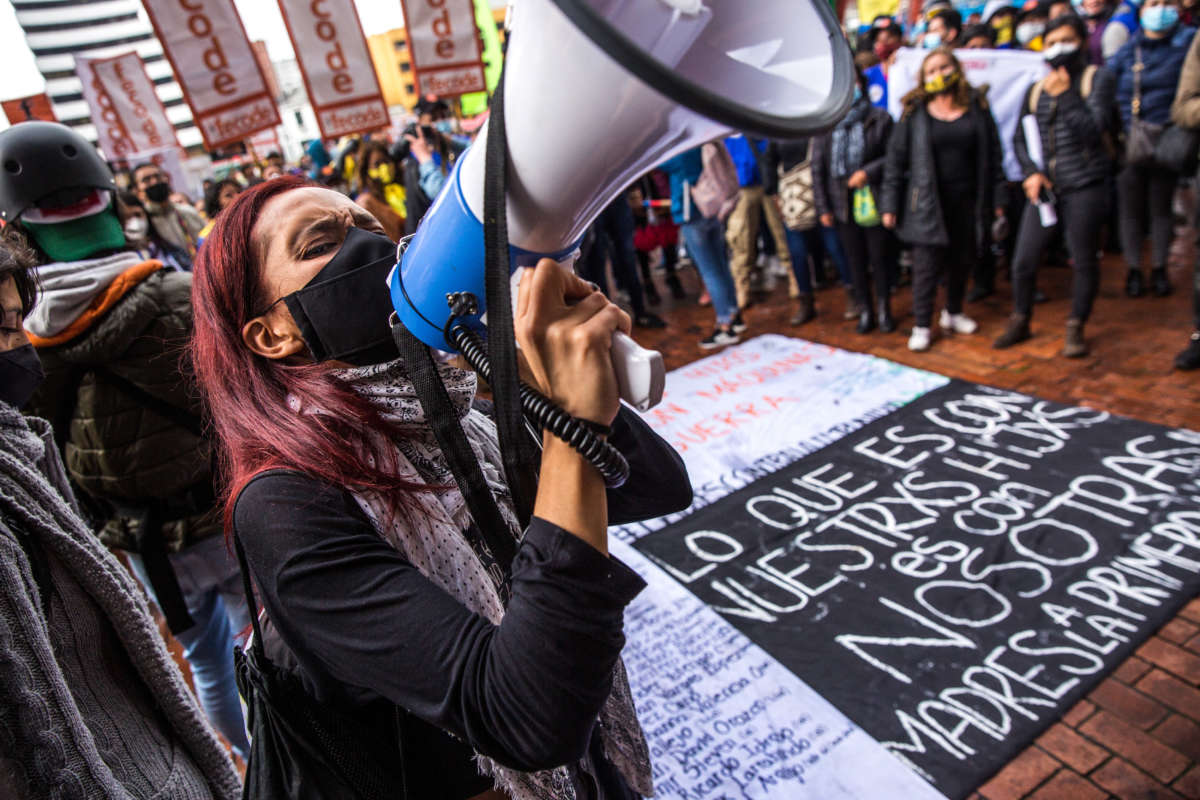Welcome to DU!
The truly grassroots left-of-center political community where regular people, not algorithms, drive the discussions and set the standards.
Join the community:
Create a free account
Support DU (and get rid of ads!):
Become a Star Member
Latest Breaking News
General Discussion
The DU Lounge
All Forums
Issue Forums
Culture Forums
Alliance Forums
Region Forums
Support Forums
Help & Search
Latin America
Related: About this forumA National Strike Has Reignited in Colombia -- and Is Winning Some Victories

A protester seen shouting the 72 names of the victims assassinated by police in front of the Tequendama Hotel, where the Inter-American Commission on Human Rights (CIDH) met with union leaders on June 9, 2021.
ANTONIO CASCIO / SOPA IMAGES / LIGHTROCKET VIA GETTY IMAGES
BY
John Walsh, Truthout
PUBLISHED
June 12, 2021
Since April 28, people in Colombia’s cities and towns have engaged in an ongoing national strike, el paro nacional. Originally called in November 2019 by the major labor federations in opposition to a package of neoliberal tax, health care, pension and education legislation emerging from the right-wing national government, the strike went dormant for a stretch after the pandemic hit Colombia, but now has resurfaced stronger than ever — and activists are starting to win some national and local victories.
Thousands have taken to the streets across the country in marches and rallies. Truck drivers have halted the movement of merchandise. Where support for the strike is strongest — in lower-income neighborhoods of cities such as Cali and Bogotá — points of resistance have formed, where by day, community and cultural activities take place, and by night, too often, police and paramilitary attacks occur, met by the opposition of the primera linea, the frontline force of low-income young people who confront “less-lethal” munitions and live gunfire with shields made from chemical drums and rocks.
Each act of protest, whether march, rally or resistance point, has its own composition and forms of expression, reflecting the diversity of contexts underlying the strike. In the city centers, artistic actions and manifestations of gender diversity have opened new spaces, while in the forgotten neighborhoods neglected by public institutions, agency is exercised by pelados/peladas, low-income young people, many from Black or campesino (peasant) families displaced from the countryside to urban areas and forced into underground economies that fill the void of economic opportunities — a generation and population without a future, unless they themselves create it, a realization which steels their resolve.

A march during the one-month mark of the national strike, Cali, Colombia, on May 28, 2021.
JOHN WALSH
Retaliatory repression by the Colombian state is violent, lawless and lethal. Statistical reports are certainly undercounts, both because of the chaotic situation and, more importantly, because victims know that being identified publicly could bring them or those close to them more harm. Even with those limitations, in the city of Cali alone, the civil society group Comisión por la Vida documented, from April 28 through May 22, 46 people killed, 93 disappeared and 240 detained by the National Police or the special riot squad, the ESMAD (Escuadron Móvil Anti-Disturbios). The number of wounded in the protests is unknown, since a portion of them do not seek treatment in clinics or hospitals for fear of being “disappeared” by the authorities lurking there — or because they have heard the reports of people being denied care once the circumstances of their being injured were known.
More:
https://truthout.org/articles/a-national-strike-has-reignited-in-colombia-and-is-winning-some-victories/
InfoView thread info, including edit history
TrashPut this thread in your Trash Can (My DU » Trash Can)
BookmarkAdd this thread to your Bookmarks (My DU » Bookmarks)
0 replies, 558 views
ShareGet links to this post and/or share on social media
AlertAlert this post for a rule violation
PowersThere are no powers you can use on this post
EditCannot edit other people's posts
ReplyReply to this post
EditCannot edit other people's posts
Rec (2)
ReplyReply to this post